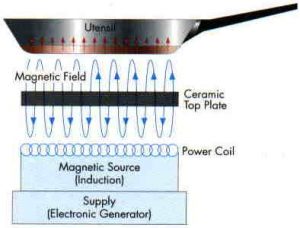Induction Cooktop
The Innovative Cooking Technology
The Cooktop Types:
Cooktop can be divided into gas and electric types. Electric type include, among others, coil, electric with ceramic top (the most common and familiar kind of “electric” cooktop), halogen heaters, and induction. Induction cooking, which deliver more than 90% energy efficiency(comparing with less than 40% for a gas stove), is by far the most cost effective cooking technology on the market.
The Technology:
Induction is a relatively new technology and is widely adopted in Europe & Asia nowadays. The design applies magnetic coil to generate high-frequency electromagnetic field under the unit’s ceramic surface. When a good-sized piece of magnetic material, such as a cast-iron pan, is placed in the magnetic field, the field transfers (“induces”) energy into the metal. That transferred energy causes cookware to generate heat itself(Eddy Current effect). By controlling the strength of the electromagnetic field, we can control the amount of heat being generated in the cooking vessel, and we can change that amount “instantaneously”. Such superior precision controls can hold temperature to within 1°C.

On the drawing, magnetic field induces a flow of electricity, within the metal of which the pot or pan is made, and generate heat by the metal resistance nature.

This technology has advantages of high efficiency, controllability, and safety. The distinct safety feature comes from the fact that ceramic glasstop itself does not become the heat source. It’s the cook pan itself generates the heat. (please see the frying egg effect in photo attached).
Safe , Fast , Clean and Cost Effective
Magnetic waves have no effect on skin or anything other than iron or steel. If the pan is accidentally removed from the cooktop, or the size of the object placed on the hob is too small….such as a wedding ring or a spoon, the auto-pan detection feature will shut off the unit instantly.
SAFE – no flames, butane or burners! Eliminates the danger of gas leakage and hot burners. Safe for children while glasstop surface remain cool.
FAST – Induction provides immediate response and precise temperature control. No waiting time, heat is instantly generated by the pan itself.
CLEAN – Flameless cooking for fresh indoor air quality, Easily cleaned with a damp cloth.
COST EFFECTIVE – Save 25% to 60% on utility bill comparing to gas & electric type cooktop.
Induction cooktops come with advanced control features, such as stand by, non-operating mode, auto-stop function, automatic-scanning functions and small-objects detector.
Pots and pans made of iron, enamel steel, certain stainless steels and types of glass cookware with metal bases are induction compatiable. Currently aluminum & copper alloy can be applied on these cookpans to improve heat distribution & efficiency.
The Energy Efficiency:
The various cooktop types are not all equally effective at converting their energy content into cooking heat; for example, gas delivers significantly less than half its total energy to the actual cooking process(30-40% efficiency), while induction delivers about 85 to 90 percent of its energy (90%+ efficiency). This is a saving of 40-70% in comparison to conventional cooktops..
| Cooking Type | Efficiency |
| Induction | >90% |
| Electric Coil | 65% |
| Electric(w/ ceramic top) | 47% |
| Gas | <40% |
There’s no heat transfer between the cooktop & the cookware. Thus minimal heat dispassion, & cut down air conditioning cost during summer.
Power Consumption
(per http://theinductionsite.com/makers.shtml, The Owlcroft Company)
- The average home gas-cooker burner is about 10K BTU;
- Serious home gas-cooker burners are about 12K BTU; and,
- Deluxe home gas-cooker burners are about 15K BTU.
- Commercial gas-cooker burner are above 30K BTU.
VS
- Average home cooking power, an induction cooker element would have to be about 1400 watts (1.4 kW);
- Serious home cooking power, an induction cooker element would have to be about 1700 watts (1.7 kW); and,
- Deluxe home cooking power, an induction cooker element would have to be about 2000 watts (2 kW).
- Commercial model consumption ranges from 3.5KW to 10KW.